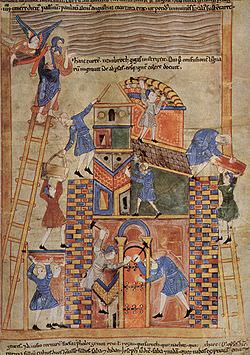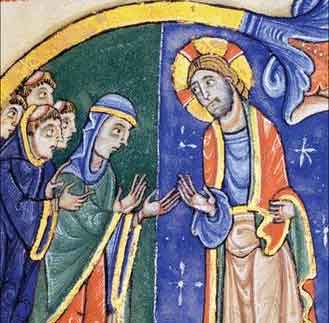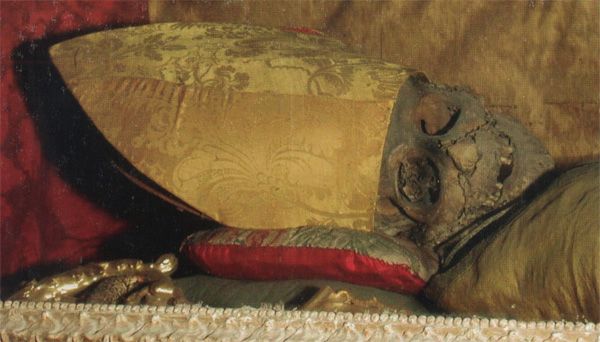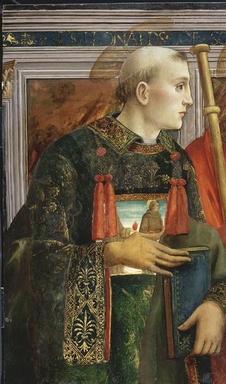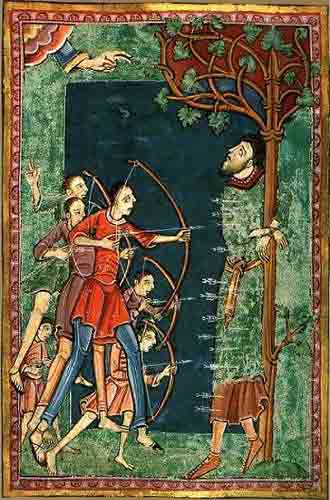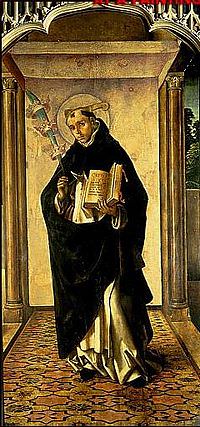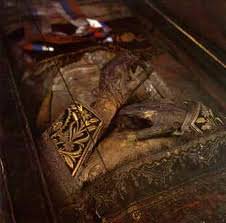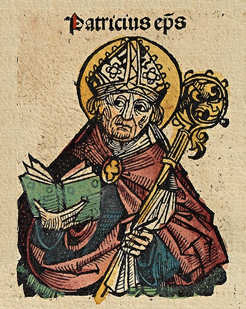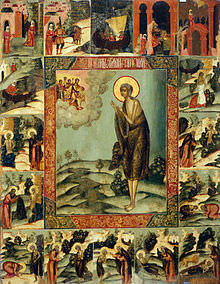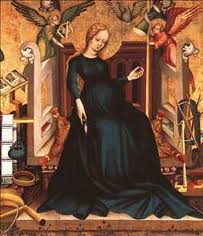The Legend of the Purgatory of Saint Patrick: From Ireland to Dante and Beyond
“Yes by Saint Patrick …. Touching this vision here It is an honest ghost, that let me tell you” (Hamlet, Act I, Scene 5)
Narratives of the saintly body in Anglo-Saxon England
This dissertation investigates narratives of the saintly body in Anglo-Saxon England. Specifically, it examines the ways in which the bodies of holy men and women were constructed through such narratives and read in local appropriations of emblematic vitae and passiones.
Scottish saints cults and pilgrimage from the Black Death to the Reformation, c.1349-1560
This thesis will question this premise and provide the first indepth study of the cults of St Andrew, Columba of Iona/Dunkeld, Kentigern of Glasgow and Ninian of Whithorn in a late medieval Scottish context, as well as the lesser known northern saint, Duthac of Tain.
Transitional Holiness in the Twelfth Century: The Social and Spiritual Identity of Domina Christina of Markyate
Visions flourish within particular domestic contexts and disciplines, and Christina enables us to glimpse a sub-culture of visionary experience in twelfth-century England, which rarely shows up in sources and is given little authority in the dominant narratives.
Mummified saints of the Northern Croatian Littoral
European mummies occupy a significant place among the world known mummies.
Pilgrimage and Embodiment: Captives and the Cult of Saintsin Late Medieval Bavaria
Chief among the stories contained in these miracle stories are tales of escapes from captivity. Almost forty percent of the reports in the two Munich Latin miracle collections deal with liberations from imprisonment and escapes from captivity of various sorts.
St Edmund of East Anglia and his miracles: variations in literature and art
Edmund was said to have been crowned at the age of just fourteen years by St Humbert on 25 December 855 in the then royal capital Burna, (probably Bures St Mary, Suffolk). Almost nothing is known of his life and reign, though he was recorded as a just and uncompromising ruler, the embodiment of the Greek ideal of the kalòs kai agathòs – that is, the right balance of the Good and the Beautiful, the combination of virtues that could create the perfect nobleman.
Britain’s Medieval identity Crisis
Clare Downham considers how a set of saints’ lives written by a13th century monk in Cumbria help us understand how national allegiances were understood in medieval Britain.
Daily Life in the Spanish Reconquest: Scenes from Tenth-Century León
Built by the Romans to garrison to Seventh Legion, León may also have been the base of the legion’s military commander, who was sometimes fully empowered by the emperor to govern Asturias and Galicia.
Holy Body, Wholly Other: Sanctity and Society in the Lives of Irish Saints
The core of hagiography, whatever else may accrete around it, is therefore the depiction of what defines a saint as a saint in the eyes of the hagiographer and his intended audience. Ireland’s hagiography must then encompass the Irish author’s understanding of an Irish saint.
A Peripheral Matter? Oceans in the East in Late Medieval Thought, Report and Cartography
Focusing in particular on the southern and eastern parts of the Ocean Sea, this article traces the broad contours of a representational and conceptual shift brought about, I argue, by the interplay between geographical thought and social (navigational, mercantile) practice.
The Bones of Saint Peter
Sometime in AD 48, Peter had a tense meeting in Jerusalem with an enthusiastic missionary called Paul, who had been travelling among the peoples of the Near East, spreading news of Jesus’ teachings. Peter and his Jewish friends in Jerusalem were anxious that male converts to the new sect should be circumcised, as a sign that their commitment was genuine.
What Do Reliquaries Do for Relics?
What is really inside the reliquary?
Comparing Pilgrim Souvenirs and Trinity Chapel Windows at Canterbury Cathedral
The story begins with two tin pilgrim ampullae2 made before 1220 in Canterbury, England, that were found centuries later, one in France (now in the Cluny Museum) and one in Norway (now in the Historical Museum in Bergen, Norway).
Martyrs on the Move: The Spread of the Cults of Thomas of Canterbury and Peter of Verona
No matter how one viewed Peter‟s and Thomas‟s personalities, the glaring fact of their instant and enduring cults forces the conclusion that their contemporaries all over Europe saw in them, and especially in their martyrdoms, desirable and compelling prototypes for Christian perfection. The spread and extent of these cults is the subject of this study.
Sacred Things and Holy Bodies: Collecting Relics from Late Antiquity to the Early Renaissance
Intimately tied to concepts of wholeness, corporeal integrity, and the resurrection of the body, the collecting of bones and body parts of holy martyrs was an important aspect of the Christian cult of relics already during Antiquity
The Pseudo-Amphilochian Vita Basilii: An Apocryphal Life of Saint Basil the Great
There is yet another aspect of Basil’s greatness which is none of his making: of Basil it is possible to know more and to know it more surely, than it is of any other person, with the possible exception of Julian
the Apostate, who lived in the first millennium A.D. The physical relics may have disappeared, but the literary remains constitute a remarkable dossier of high historical value.
Eve and Her Daughters: Eve, Mary, the Virgin, and the Lintel Fragment at Autun
The lintel fragment of Eve from the Cathedral of St. Lazaire at Autun (Figure 1) has been praised by art historians as one of the greatest monumental figural works of the Romanesque period.
Saint Patrick and the Druids: A Window into Seventh-Century Irish Church Politics
Through an analysis of selected portions of Muirchú’s Life of Saint Patrick, this thesis will attempt to search out the hagiographer’s goals in writing as he did under the direction of Aed, Bishop of Sletty, during a critical time of debate in the Irish church. The primary method of accomplishing this will be through consideration of Patrick as a character in the hagiography.
Personal Piety or Priestly Persuasion: Evidence of Pilgrimage Bequests in the Wills of the Archdeaconry of Sudbury, 1439-1474
However, when we consider the number of individuals, particularly from the lower orders, who actually undertook a pilgrimage at some point in their lives, we find that we actually know remarkably little about them.
VAGANTES: Between Tradition and Change: Monastic Reform in Three fifteenth-century German Redactions of the Life of Saint Mary of Egypt
Using the life of St. Mary of Egypt, this paper will consider three different Middle High German versions produced by reform communities and will analyze how the reform ideologies and goals manifest in the texts.
VAGANTES: Necessary Imperfection: The Body of Sainte Marie l’Egyptienne
This paper seeks to examine the role of the body and its relationship to the world around it in the “vie de sainte” of Marie l’Egyptienne, who is an excellent example of a female saint who begins life as a sinner and transforms her body into something holy. This presentation will focus on the version of Marie l’Egyptienne’s life written by Rutebeuf in the 13th century, but will also bring in elements of other versions and of the stories of other female saints who transform their bodies for comparison.
VAGANTES: What the Body Said: The Corpse-as-Text in St. Erkenwald
This paper will consider how the speaking corpse of the pagan judge should be read, especially in light of the hagiographic context and medieval theological writings on the resurrection of the body.
The Thread of Life in the Hand of the Virgin
The motif of the Virgin at the loom occurred with frequency in Western art only after the Feast of the Presentation of the Virgin (celebrated by the Byzantine Church on November 21 from the seventh or eighth century onward) was introduced into the West in 1372.
HAPPY ST.PATRICK’S DAY: Books on all things Irish! Sláinte!
Celebrate St. Patrick’s Day with these great reads and some green beer!

